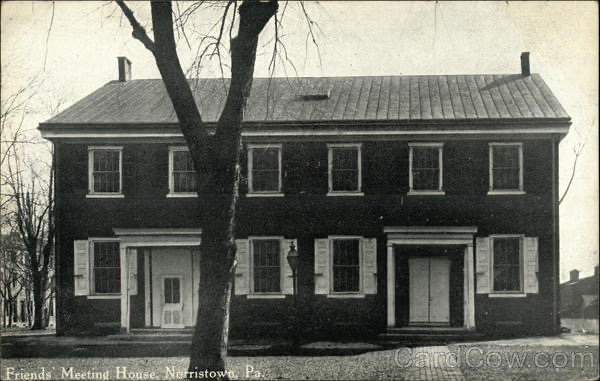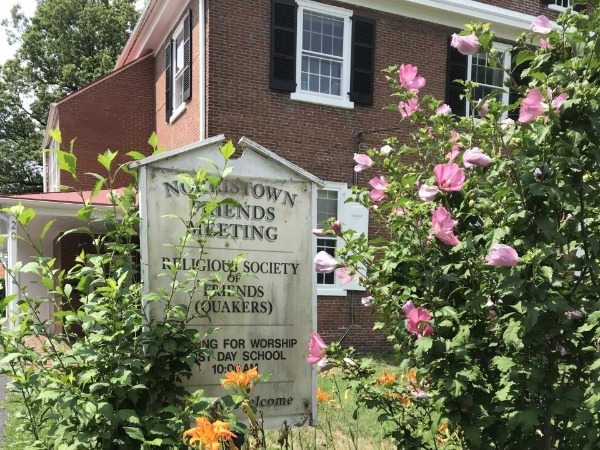Norristown Friends History

And so, I find it well to come
For deeper rest to this still room,
For here the habit of the soul
Feels less the outer world's control;
The strength of mutual purpose pleads
More earnestly our common needs;
And from the silence multiplied
By these still forms on either side,
The world that time and sense have known
Falls off and leaves us God alone.
- John Greenleaf Whittier
Although the Society of Friends was the first organized religious movement in Pennsylvania, other than the Swedish Lutherans, the Friends did not gain a foothold in Norristown until after most of the other denominations had opened churches. The first mention of any Friends' Meetings in Norristown is found in the Journal of Elias Hicks. In his entry for 9th month, 24th (September 24), 1817, he says: "On the fourth day we had an appointed meeting in a Village called Norristown. It was held in their Court House, there being only a few scattered members of our Society in the place."
By 1842, however, there was a sufficient number of members of the Religious Society of Friends residing in Norristown and vicinity who desired to establish a Meeting in Norristown. They were members of Gwynedd, Plymouth and perhaps Valley Meetings. In those days, it was quite a journey to attend Meeting. Read more here.
The Underground Railroad
[The town of] Norristown first became a station of the Underground Railroad about 1839, the year of the first meeting of the Anti-Slavery Society at that place. The number of fugitives who passed through there, assisted by their friends, increased from year to year, as many as fifteen or twenty being occasionally concealed within the town at one time. -from History of Montgomery County, Pennsylvania, Volume 1, edited by Theodore Weber Bean.
Abolition scholar Charles L. Blockson notes that in Montgomery County "most whites were lukewarm in regard to aiding escaping slaves. Some whites were sympathetic and willing to help in time of real need, but they did not want their involvement generally known. Consequently, here too blacks did most of the real fugitive-aid work, such as providing shelter and rescuing escaped slaves in trouble. Among the better known blacks involved were Ben Johnson, John August, and Dan Ross of Norristown." -Charles L. Blockson, The Underground Railroad (New York: Prentice hall, 1987), 238.
Lucretia Mott was one Quaker who was steadfast and outspoken in her support of abolition and the underground railroad. Lucretia Mott was a speaker at an anti-slavery meeting held in the Norristown Baptist Church, which was the only church in the town that permitted such meetings. Another speaker at this meeting was Frederick Douglass, noted Black orator. After the meeting, according to the tradition, Douglass and Mrs. Mott walked away from the church arm in arm. This stirred up a riot by a crowd that had already shown its antagonism by stoning the church windows. Friends had to hustle them off to the home of one of the leaders in the Abolition movement.
A local Norristown theatre, Theater Horizon, performed a play in 2020 called The Agitators, about the relationship between Frederick Douglass and Susan B. Anthony. "Youthful hopes and dreams united them in their fight to end slavery, but over time, their disagreements about how to gain voting rights tested their alliance." The play was cancelled due to COVID-19. Hopefully, it can be resumed at a later date.
Dates in the History of Norristown Meeting of the Religious Society of Friends
1581 - Charles II grants a charter for all the land in Pennsylvania to William Penn
1682 - Penn arrives in Pennsylvania
1689 - Penn creates the Manor of Williamstadt for his son William. The manor included what is now Norristown and the two Norritons
1704 - William Penn, Jr., sells the manor land to Isaac Norris and William Trent
1710 - Norris purchases all of the tract from Trent
1780 - By petition the Township of Norriton is created
1784 - Montgomery County is formed out of what had previously been a large part of Philadelphia County. The
small village of Norristown is named the county seat.
1812 - Norristown becomes a borough. Saint John's Episcopal Church, the first church in the borough, is formed.
1842 - On April 7, 1842, land on the corner of Swede and Jacoby Streets is deeded by Samuel Jacoby and his wife, Susanna, to Lindley Rossiter for the sum of $1,237.50. 113 persons contribute to this purchase. Lindley Rossiter requests Gwynedd Monthly Meeting to appoint trustees to accept about 2 1/2 acres of ground in the Borough of Norristown for "the purpose of furnishing a situation for a meetinghouse for Friends, and for a graveyard." Trustees are appointed and the first steps toward organization begin. The construction of the Meetinghouse begins.
1852 - Construction of the Meetinghouse is completed and from old bills found, cost about $5,000. The first meeting for worship is held 16th of 5th month (May 16). Norristown Meeting opens as an Indulged Meeting under Gwynedd Meeting care. The brief report in the newspapers said the house was ‘filled to overflowing’. The chief speakers were Joseph Foulke, a noted schoolmaster in Gwynedd, and Lucretia Mott, widely known Quaker preacher and leader in the anti-slavery movement.
1860 - Norristown Meeting becomes a Preparative Meeting of Gwynedd Monthly Meeting.
1867 - The preparative meeting at Upper Providence is laid down and its members attached to Norristown.
1872 - The trustees are authorised to sell "all or part of the lot on Jacoby Street---60 feet front and running back to the public school lot". This is done at a public sale and the proceeds helped defray the cost of curbing and paving, and for the errection of an iron fence. The sale of these lots leave the property as it is today.
1936 - Gwynedd, Plymouth, and Norristown Preparative Meetings become separate monthly meetings.
1952 - Norristown Friends Meeting celebrates its centennial.
1953 - Norristown Friends Meeting becomes an independent Monthly Meeting.
1958 - The Meetinghouse undergoes extensive remodeling to provide a second floor within the original structure's high ceiling to form a social floor with kitchen, stage, library and partitions to form two additional First Day School classrooms.
2003 - Norristown Friends Meeting ends its one-year sesqui-centennial celebration.
